You might be surprised to learn that many viral memes started from humble or accidental origins, like a stock photo becoming “Distracted Boyfriend,” a cute dog snapping into “Doge,” or a prank that turned into “Rickrolling.” Some, like “Success Kid” and “Grumpy Cat,” emerged from genuine moments, while others, like “Nyan Cat,” gained fame through randomness. To see how these unlikely roots shaped today’s internet culture, keep exploring their fascinating stories.
Key Takeaways
- Many viral memes originate from simple, relatable images or moments that gain popularity through social media sharing.
- Iconic memes like “Doge” and “Rickrolling” began as spontaneous internet jokes before evolving into cultural phenomena.
- Memes such as “Success Kid” and “This Is Fine” stem from authentic or humorous moments that resonate emotionally.
- The virality often relies on humorous, absurd, or unexpected elements that encourage remixing and community participation.
- Memes frequently reflect societal values, rebellion, or shared experiences, amplifying their surprising and widespread popularity.
The Birth of the Distracted Boyfriend Meme

The Distracted Boyfriend meme originated from a stock photo that captures a man turning his head to check out another woman while his girlfriend looks on disapprovingly. This image quickly became a prime example of viral branding, as its relatable scene invited countless variations. Understanding meme psychology helps explain its success: viewers see a humorous reflection of distraction and temptation, sparking shared experiences. The meme’s simplicity and universal theme make it easy to customize, fueling its rapid spread across social media platforms. Its visual clarity and comedic timing tapped into collective feelings of distraction, making it highly shareable. Additionally, the meme’s cultural significance illustrates how a single, well-placed image can harness meme psychology and achieve viral fame.
How “Doge” Took Over the Internet

You’ve probably seen Doge’s iconic Shiba Inu face everywhere, but its journey from a simple meme to internet icon is fascinating. Its origin traces back to a 2010 photo that quickly evolved into a viral sensation, influencing online culture along the way. Today, Doge’s impact extends beyond memes, shaping how we communicate and share humor online. Additionally, the use of viral content in digital spaces has become a powerful tool for cultural dissemination and engagement.
Origin and Evolution
Ever wonder how a simple Shiba Inu meme skyrocketed into an internet phenomenon? It all begins with digital anthropology, where online communities shape the meme’s evolution. The “Doge” meme evolved through meme linguistics, where the distinctive use of broken English and internal monologue became its signature. As it spread across forums like Reddit and 4chan, its meaning shifted from a cute dog picture to a symbol of humor and irony. The meme’s adaptability allowed users to remix and reinterpret it, fueling its viral growth. Over time, “Doge” became more than just an image; it became a cultural icon, illustrating how memes evolve from niche humor to global phenomena. Understanding this process reveals how memes like “Doge” reflect collective online identity and linguistic innovation. Memetic evolution demonstrates how digital culture transforms simple images into powerful symbols of shared identity.
Cultural Impact
How did a meme featuring a Shiba Inu become a global cultural icon? “Doge” took over the internet by resonating with diverse audiences through its humor, irony, and relatability. Its rise exemplifies meme evolution within digital culture, transforming from a simple photo into a symbol of internet humor. As “Doge” spread, it influenced memes, marketing, and even cryptocurrency, showing how a meme can shape broader social trends. You see its impact in viral challenges, merchandise, and online conversations, proving that memes are more than just jokes—they reflect cultural values and shared experiences. “Doge”’s popularity highlights how meme culture transcends entertainment, becoming an integral part of digital identity and communication worldwide. Its influence underscores the power of memes to shape modern culture. Additionally, the evolution of memes like “Doge” demonstrates the significance of cultural impact in understanding digital trends and social dynamics.
The Hidden History Behind “Rickrolling

You might be surprised to learn how “Rickrolling” started as an unexpected internet prank and evolved into a cultural phenomenon. Its roots trace back to early online communities, and over time, it transformed into a widespread meme that persists today. This hidden history reveals how a simple bait-and-switch can shape internet culture and influence viral trends.
Origins and Evolution
The origins of “rickrolling” trace back to the mid-2000s, when internet users began unexpectedly redirecting others to the music video for Rick Astley’s 1987 hit “Never Gonna Give You Up.” This prank gained popularity through viral psychology, as people loved the surprise factor and catchy tune. Over time, meme commercialization transformed rickrolling from a simple joke into a cultural phenomenon. Its evolution showcases how memes adapt and spread across platforms, maintaining relevance through humor and surprise. Additionally, the rise of viral marketing strategies has further propelled its longevity and cultural impact. Below is a table outlining key moments in its development:
| Year | Event | Impact |
|---|---|---|
| 2007 | First rickrolls appear | Viral surprise spread |
| 2008 | Mainstream websites adopt | Cultural recognition |
| 2010 | Commercial campaigns begin | Meme monetization |
| 2015 | Celebrity rickrolls occur | Broader audience engagement |
This evolution highlights how memes, like rickrolling, capitalize on viral psychology and commercialization strategies.
Cultural Impact
As rickrolling grew from a simple online prank into a widespread cultural phenomenon, its impact extended far beyond the internet’s borders. It became a form of social commentary, subtly highlighting the playful defiance of authority and norms. For you, it symbolizes more than just a meme; it marks a shift in how generations communicate and share humor. Younger audiences embraced rickrolling as a way to challenge traditional media and expectations, reflecting broader generational shifts toward digital spontaneity. It also bridged gaps between different age groups, creating a shared inside joke that crosses cultural boundaries. Ultimately, rickrolling’s cultural impact reveals how a simple prank can evolve into a symbol of unity, rebellion, and adaptability in an ever-changing digital landscape. Additionally, this phenomenon exemplifies how viral trends can resonate emotionally and symbolically across diverse communities.
Origins of the “Success Kid” Photo
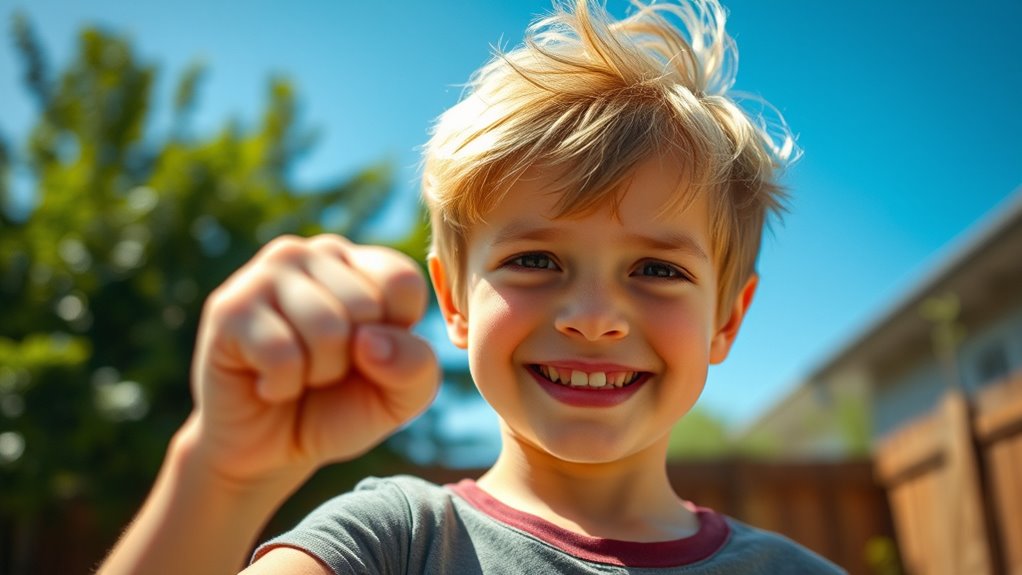
The “Success Kid” meme originates from a 2007 photograph of a young boy named Sammy Griner, whose determined fist and mischievous expression captured internet users’ attention. This image became a powerful tool in viral marketing, as people quickly recognized its relatable message of triumph and persistence. Understanding meme psychology helps explain why this photo resonated so strongly—viewers saw a symbol of victory that they could project their own successes onto. Its simplicity and emotional appeal made it easy to customize with captions, fueling its rapid spread across social media platforms. The meme’s widespread popularity demonstrates how a genuine, authentic moment can transform into a viral phenomenon, illustrating the seamless blend of visual impact and psychological connection that defines successful memes. Additionally, the role of social media platforms in facilitating rapid sharing was crucial in amplifying its reach.
The Unexpected Roots of “This Is Fine
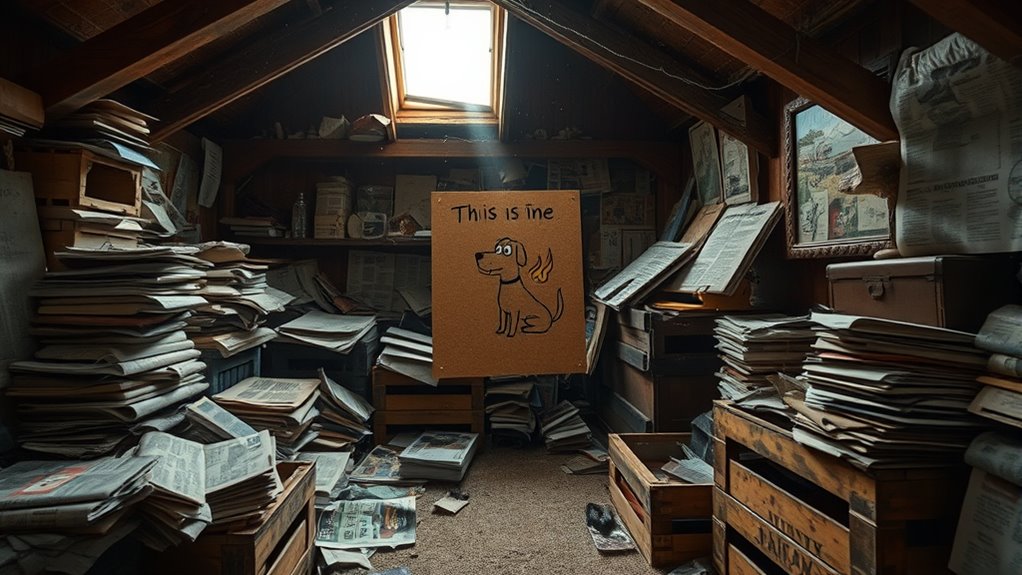
While the “Success Kid” meme showcases how genuine moments can spark widespread viral appeal, some memes have surprisingly unexpected origins that add layers of meaning. “This Is Fine” is a prime example, rooted in a simple comic strip that became a symbol of meme psychology during stressful times. Originally created by KC Green, the comic depicted a dog calmly sitting in a burning room, saying, “This is fine,” a relatable reaction to chaos. Its rise to viral trends highlights how humor and irony resonate during uncertain moments. You might not realize that this meme taps into collective feelings of helplessness and denial, making it more than just a funny image. Its unexpected roots remind you that memes often reflect deeper emotional truths, fueling their viral power. Additionally, some unique and wicked planters are designed to evoke similar feelings of comfort and resilience through creative and humorous plant displays.
The Story Behind the “Grumpy Cat” Phenomenon
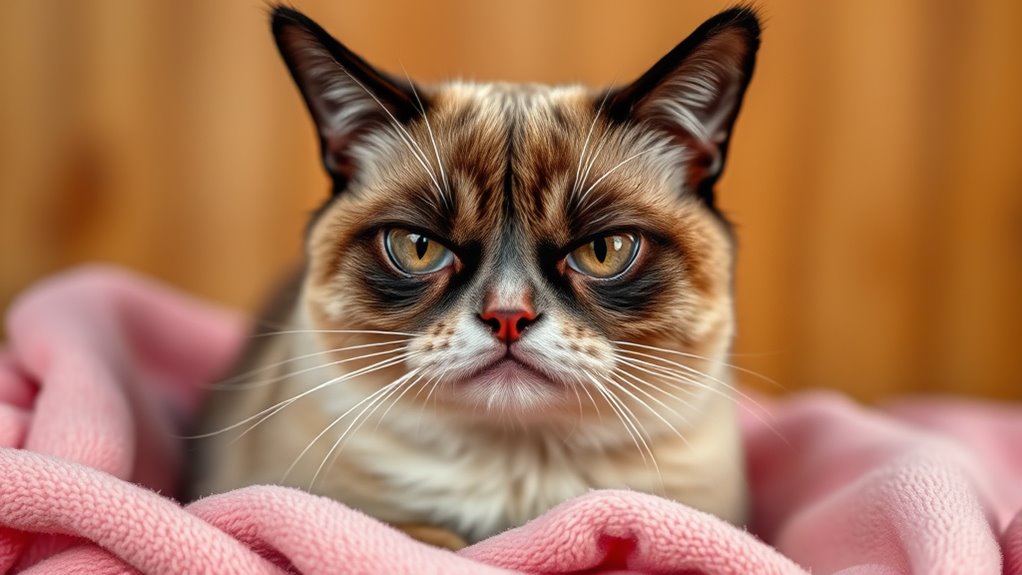
Behind the viral fame of Grumpy Cat lies a story of chance and internet serendipity. Her rise exemplifies how viral marketing leverages meme psychology to capture attention. A simple photo of Tardar Sauce’s perpetually grumpy face became an instant sensation, illustrating the power of relatability and humor. The meme’s visual simplicity and ability to evoke shared emotions played a crucial role in its widespread popularity. You’ll notice that:
Viral fame often springs from chance, showing how humor and relatability make memes unforgettable.
- The meme’s humor taps into shared feelings of annoyance or dissatisfaction, making it highly relatable.
- Its simplicity allowed users to customize captions, fueling rapid spread.
- The authenticity of her expression created a genuine emotional connection, encouraging sharing.
This phenomenon shows how an unintentional image can become a cultural icon, demonstrating the unpredictable nature of viral content and the psychological triggers that make memes stick.
The Accidental Fame of “Nyan Cat
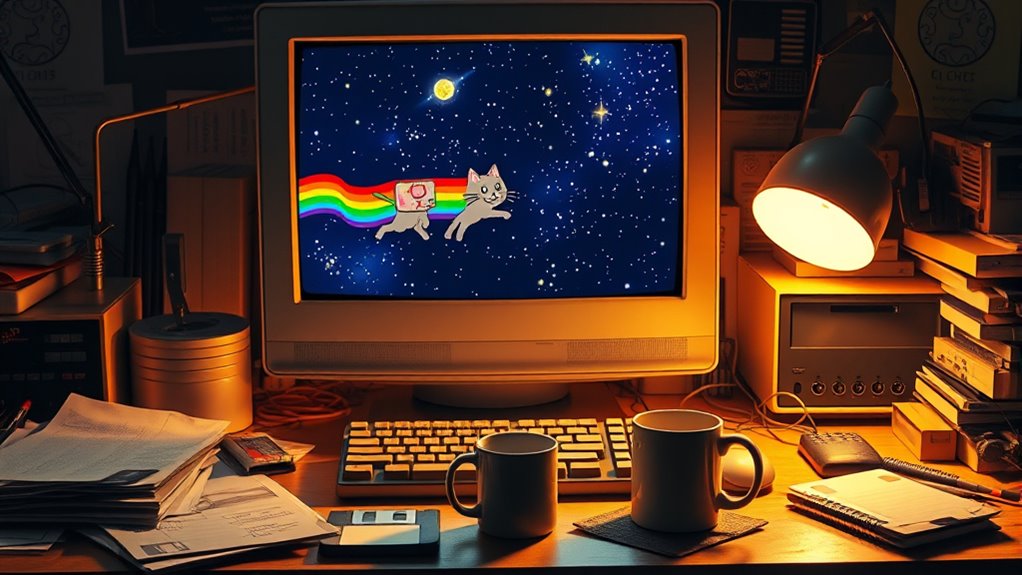
Just as Grumpy Cat’s fame grew from a simple, relatable image, Nyan Cat’s viral rise stemmed from an unexpected digital creation that captured the internet’s imagination. Its colorful, catchy animation combined with meme psychology—humor, absurdity, and simplicity—made it irresistible. You notice how viral marketing played a role, with early sharing fueling its spread across platforms. The meme’s playful randomness appealed to a wide audience, encouraging endless variations and remixes. Its success illustrates how a quirky, unintentional creation can become a cultural phenomenon through networks of sharing and engagement. Nyan Cat’s rise highlights the power of authenticity and humor in meme psychology, proving that sometimes, the most viral content is born from spontaneity rather than strategy.
| Concept | Explanation |
|---|---|
| Viral Marketing | Spreading through shares, views, and reposts |
| Meme Psychology | Appeal rooted in humor, absurdity, relatability |
| Simplicity | Easy to understand and replicate |
| Randomness | Surprising, unexpected elements drive sharing |
| Engagement | Community participation enhances virality |
Tracing the “Woman Yelling at Cat” Meme
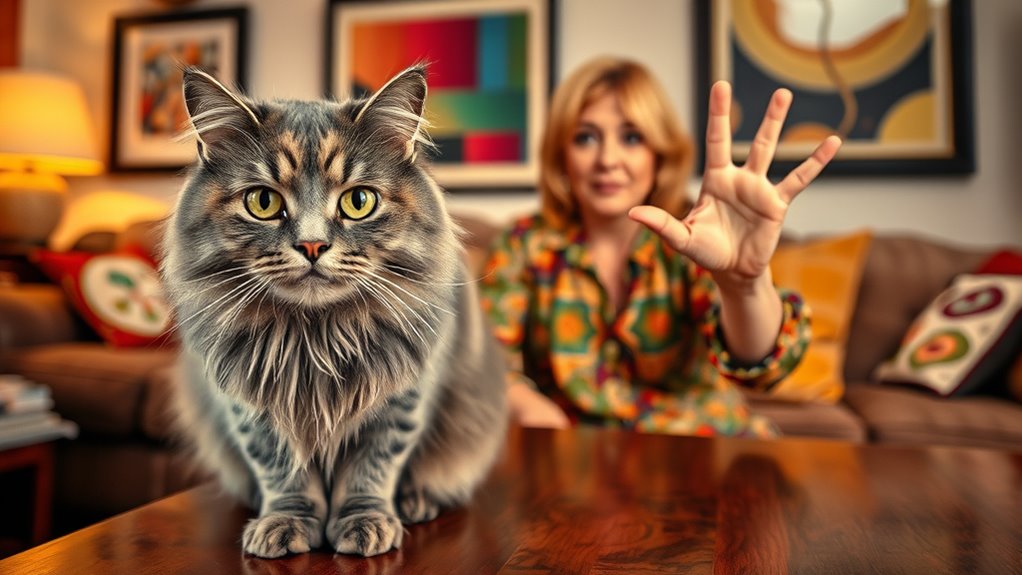
Have you ever wondered how the “Woman Yelling at Cat” meme took over the internet? This viral mashup combines a screenshot of TV personality Taylor Armstrong yelling with an image of a confused white cat named Smudge. Its success lies in meme psychology—people connect emotionally and humorously by pairing contrasting images. The meme’s rapid spread showcases viral marketing at its best, as users share relatable or absurd scenarios. Additionally, the simplicity of the meme’s design allows for endless remixing and adaptation, fueling its widespread popularity.
The Surprising Start of “ Pepe the Frog”
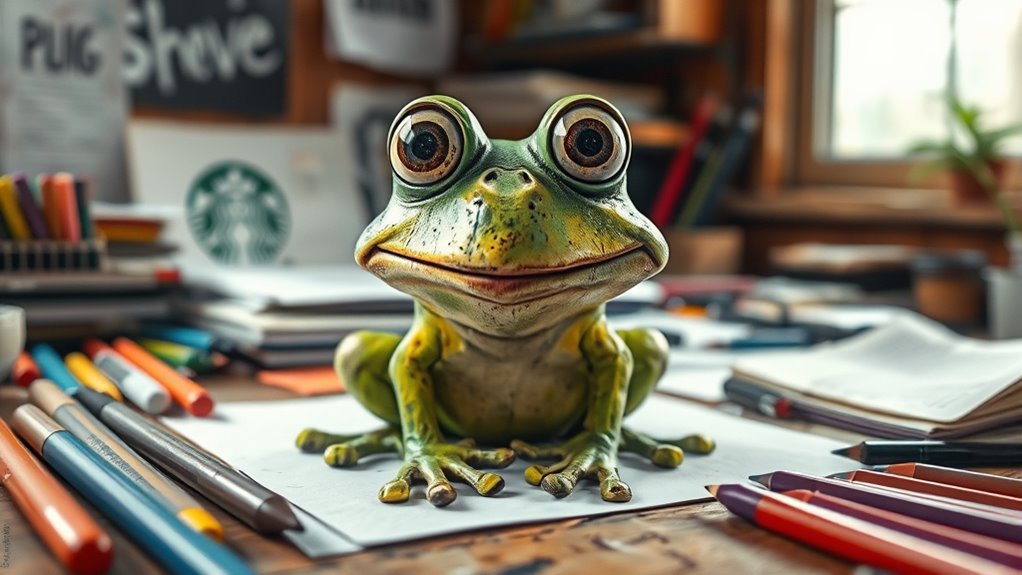
While the “Woman Yelling at Cat” meme exemplifies how humorous images can connect people online, some memes have origins that are far more unexpected. Take Pepe the Frog, for example—it started as a simple comic character created by Matt Furie. In digital anthropology, Pepe’s transformation shows how online communities can reshape a meme’s meaning, shifting from harmless humor to a symbol with complex cultural implications. Meme psychology helps explain why Pepe became so viral; its adaptable expression made it relatable across different contexts. You might not realize that a peaceful comic frog could become a controversial icon, but this evolution highlights how memes can evolve unpredictably, reflecting collective attitudes and misconceptions. Pepe’s start reminds us that memes are more than humor—they’re powerful symbols shaped by online interactions.
Frequently Asked Questions
What Cultural Factors Contributed to the Viral Spread of These Memes?
You see, social dynamics and generational trends play a huge role in how memes go viral. As new ideas and humor resonate with specific age groups, they spread rapidly through social media platforms. You notice younger generations often embrace trends quickly, shaping online culture. This collective shift fuels meme popularity, making them relatable and shareable, which in turn accelerates their viral spread across diverse communities.
How Have These Memes Influenced Popular Culture Beyond the Internet?
These memes absolutely revolutionize popular culture, shaping everything from social commentary to fashion trends. You see, they influence how people express themselves and spark conversations about societal issues. Their humor and relatability create a shared language that transcends the internet, impacting real-life interactions. Memes are now a powerful tool for commentary and trendsetting, proving that digital humor can drive cultural change in ways you might have never imagined.
Were Any of These Memes Originally Created With Malicious Intent?
You might wonder if any memes started with malicious intent. Some meme origins do involve harmful motives, like spreading misinformation or targeting individuals. However, many memes evolve from innocent humor or cultural moments, unintentionally taking on a malicious tone later. It’s important to recognize that while some memes have malicious roots, most are created to entertain or connect people, not to harm. Always critically evaluate meme origins before sharing.
What Role Did Early Internet Platforms Play in Meme Propagation?
You see, early internet platforms like forums and meme communities played a huge role in spreading memes quickly and widely. These platforms allowed users to share and remix content, creating a viral effect. You could participate in discussions, evolve memes, and see how others responded. This active engagement helped memes gain momentum, turning a simple joke or image into a cultural phenomenon in no time.
How Have Copyright Laws Impacted the Sharing of These Iconic Memes?
Think of copyright laws as fences around a shared garden. They aim to protect creators but often block meme sharing. You may face copyright disputes or legal challenges if you use copyrighted images or videos without permission. This limits how freely you can remix or share memes, making creators more cautious. Ultimately, these laws shape the meme landscape, balancing creative freedom with legal rights.
Conclusion
Now that you’ve uncovered these surprising origins, you see memes aren’t just fleeting trends—they’re like seeds planted in everyday moments, waiting to bloom into viral sensations. Each meme’s story is a hidden thread in the fabric of internet culture, weaving humor, chaos, and creativity together. So next time you laugh at a meme, remember, behind that smile lies a story as rich and unexpected as a treasure map waiting to be explored.









